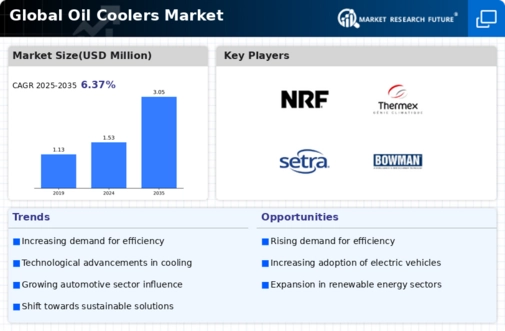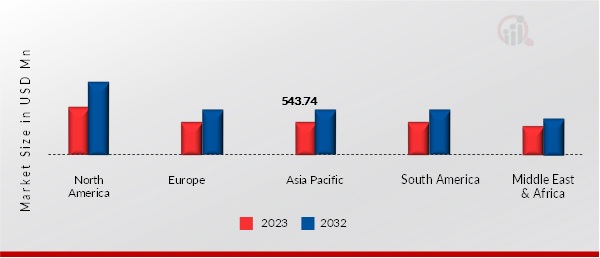Rising Focus on Increasing the Efficiency of Several Industrial Equipment Will Fuel the Oil Coolers Market
The rising emphasis on enhancing the efficiency of various industrial equipment is expected to have a significant impact on the oil cooler market. The demand for increased efficiency in industrial machinery, such as engines, hydraulic systems, and compressors, is driving the need for effective thermal management solutions, and oil coolers play a crucial role. Oil coolers are essential components in industrial machinery for regulating operating temperatures. Efficient temperature control is critical for optimizing the performance and lifespan of equipment.
As industries strive for higher levels of productivity and energy efficiency, maintaining optimal operating temperatures becomes paramount, making oil coolers a key solution. Efficient cooling of oil ensures that industrial equipment operates within the recommended temperature range. This is particularly important for heavy-duty machinery, where overheating can lead to reduced efficiency and potential damage. Improved cooling, facilitated by advanced oil cooler technologies, contributes to higher efficiency by preventing thermal degradation and ensuring consistent performance.
Energy efficiency is a major concern across industries to reduce operational costs and environmental impact. Oil coolers, by promoting efficient heat dissipation, contribute to overall energy conservation efforts. As industries face increasing pressure to adopt sustainable practices, the integration of energy-efficient components like oil coolers aligns with these goals. Maintaining optimal operating temperatures through effective oil cooling helps in extending the lifespan of industrial equipment. This is particularly crucial for industries where capital investments in machinery are significant.
The longer lifespan of equipment, achieved through proper thermal management, contributes to cost savings and supports a more sustainable approach to industrial operations. An ongoing advancement in oil cooler technology, including the development of compact and high-performance units, caters to the evolving needs of modern industrial equipment. Innovations in materials, design, and manufacturing processes are enhancing the efficiency of oil coolers, making them more adaptable to diverse industrial applications.
Rising Adoption of High-Performance Vehicles Will Demand Superior Oil Coolers, Thereby Escalating the Market Demand for Oil Coolers
The rising adoption of high-performance vehicles has significantly impacted the automotive industry, necessitating advancements in various components to meet the demand requirements of these powerful machines. One of the crucial aspects that has gained prominence is the need for superior oil cooling systems. As high-performance vehicles push the limits of combustion engines and generate elevated levels of heat, efficient oil cooling becomes paramount for maintaining optimal engine performance and longevity. High-performance vehicles, characterized by powerful engines and enhanced capabilities, produce greater amounts of heat during operation.
The intense heat generated during high-speed driving, aggressive acceleration, and high-performance applications can lead to elevated temperatures in the engine compartment. To counteract this, advanced oil cooling systems are essential to dissipate heat effectively and prevent overheating, ensuring the engine operates within its optimal temperature range. Superior oil coolers play a crucial role in preserving engine performance and longevity. High-performance engines operate under more strenuous conditions, and effective oil cooling helps maintain the viscosity and integrity of the lubricating oil.
This, in turn, ensures proper lubrication of engine components, reduces friction, and prevents premature wear and tear, ultimately extending the lifespan of the engine.
As the automotive industry continues to evolve, technological advancements in oil cooler design and manufacturing are on the rise. Innovations such as advanced materials, improved heat exchange mechanisms, and integrated cooling solutions are becoming integral to the development of high-performance oil coolers. These technological enhancements not only address the current demands of high-performance vehicles but also pave the way for future improvements in oil cooling technology.
The escalating demand for high-performance vehicles translates directly into an increased market demand for superior oil coolers. Automotive manufacturers, aftermarket suppliers, and consumers alike recognize the critical role that efficient oil cooling plays in the performance and durability of high-powered engines. Consequently, the market for oil coolers is expected to witness substantial growth as the adoption of high-performance vehicles continues to rise.
Rapidly Growing Industrialization Will Boost the Market of Oil Coolers
The increasing pace of industrialization worldwide has profound implications for various sectors, and one area that stands to benefit significantly is the market for oil coolers. Industrialization is characterized by the expansion of manufacturing activities, infrastructure development, and the growing use of machinery and equipment in diverse sectors. As industrial processes become more sophisticated and demanding, the need for effective cooling solutions, including oil coolers, becomes paramount. With the surge in industrialization, there is a corresponding increase in the deployment of heavy machinery and equipment across various industries.
These machines often operate under strenuous conditions, leading to elevated temperatures in their engines and hydraulic systems. To maintain optimal performance and prevent mechanical failures, efficient oil cooling systems are essential. This heightened demand for industrial machinery sets the stage for a parallel increase in the demand for advanced oil coolers.
Industrial processes, especially in manufacturing, involve a wide range of machinery and equipment that generate substantial amounts of heat during operation. Effective thermal management is crucial to ensure the longevity and reliability of these assets. Oil coolers play a vital role in dissipating heat generated by hydraulic systems, compressors, and other machinery, contributing to the overall efficiency and uninterrupted operation of industrial processes. As industrial operations become more intricate and demanding, the need for efficient cooling solutions intensifies.
Oil coolers are integral components in the cooling systems of various industrial applications, including hydraulic systems, power generation, and heavy equipment. The rising demand for cooling solutions aligns with the broader trend of industrialization, creating a growing market for oil coolers. Industrialization often leads to the expansion of automotive and manufacturing sectors. Both sectors heavily rely on machinery and equipment that require effective cooling solutions. The automotive industry is witnessing growth in demand for industrial vehicles, construction equipment, and other heavy-duty machinery, all of which contribute to the increasing market demand for robust oil cooling systems.
The growing industrialization has spurred advancements in technology, impacting the design and capabilities of oil coolers. Manufacturers are developing oil coolers with improved heat exchange efficiency, durability, and adaptability to diverse industrial applications. These technological advancements align with the evolving needs of industrial processes, further driving the market for advanced oil cooling solutions.
The increasing demand for efficient thermal management solutions in various industries is driving innovation and growth in the oil coolers market, as companies seek to enhance performance and sustainability.
U.S. Department of Energy
















Leave a Comment